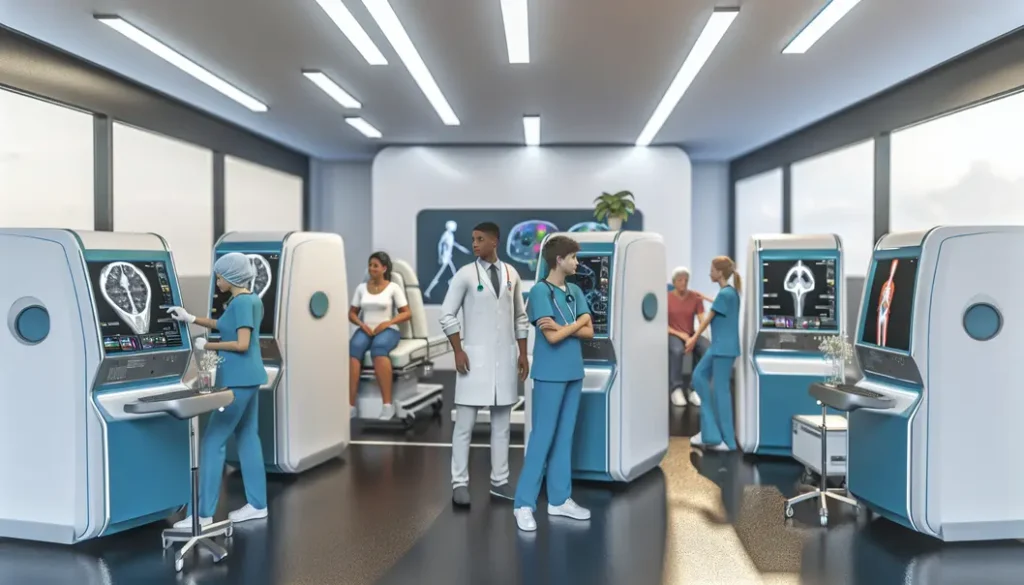Auto accident injuries present complex challenges requiring advanced treatment modalities. As medicine evolves in 2025, innovative approaches are reshaping how healthcare professionals, including auto accident injury doctors, facilitate faster, more effective recoveries. These advancements not only enhance patient outcomes but also improve pain management and functional restoration. Understanding these new treatment options is essential for individuals seeking optimal care after a collision, ensuring they access the most effective interventions available. This article explores the latest innovations transforming auto accident injury recovery in 2025.
Revolutionary Diagnostic Techniques for Precision Injury Assessment
In 2025, the clinical landscape for auto accident injury assessment has been transformed by cutting-edge diagnostic innovations. At the forefront are advanced medical imaging rooms equipped with state-of-the-art 3D MRI scanners, which surpass traditional MRI capabilities by providing intricately detailed three-dimensional visualizations of soft tissues, bones, and neural structures. These high-resolution images enable clinicians to detect even subtle injuries that might elude conventional scans, facilitating more accurate diagnoses.
Complementing 3D MRI technology are AI-powered diagnostic tools that revolutionize image analysis. These intelligent systems rapidly interpret complex imaging data, highlighting areas of concern with unprecedented precision. They assist physicians by quantifying injury severity, identifying patterns indicative of traumatic brain injuries, ligament tears, or internal bleeding, thereby streamlining decision-making and reducing diagnostic errors.
Within this clinical environment, multidisciplinary teams of medical professionals collaborate to analyze these detailed images. They leverage AI-generated insights, correlating imaging findings with patient histories and symptoms. This holistic approach ensures a comprehensive understanding of injury mechanisms, vital for tailoring personalized treatment plans.
The integration of innovative imaging and AI tools extends beyond mere visualization. Real-time data acquisition and analysis enable prompt intervention, particularly crucial for patients with complex or multi-faceted injuries. For instance, immediate detection of hemorrhages or spinal cord injuries allows for swift surgical consultation, potentially preventing long-term disabilities.
Furthermore, the clinical setting emphasizes the seamless incorporation of these technologies into routine practice. Automated workflows reduce wait times, improve diagnosis consistency, and enhance precision. These advancements also support minimally invasive procedures, as precise imaging guides interventions like targeted injections or laser treatments.
As the landscape advances, clinics are increasingly adopting these diagnostic modalities to refine injury assessments, improve patient outcomes, and set new standards in post-accident care. For detailed insights on treatment pathways following accurate injury diagnosis, see this comprehensive guide on injury treatment services. The intersection of innovation and expertise in these diagnostic techniques stands as a testament to how technology is revolutionizing recovery after auto accidents, promising quicker, more accurate, and personalized care for patients in 2025.
Innovative Therapies Reshaping Auto Accident Injury Recovery
In the realm of auto accident injury treatments in 2025, regenerative therapies have emerged as game-changers. During a typical therapy session, patients lie comfortably in specialized treatment areas, where healthcare professionals employ the latest minimally invasive techniques to promote natural healing. One such approach involves stem cell therapy, where preserved cells are carefully injected into injured tissues, stimulating regeneration and reducing inflammation. Using advanced imaging-guided precision equipment, practitioners target specific areas such as damaged ligaments, tendons, or cartilage, maximizing efficacy while minimizing discomfort.
Laser therapy, another promising modality, harnesses concentrated light energy to accelerate cellular repair. The clinician operates a state-of-the-art laser device, directing precise pulses onto affected regions. Patients often experience reduced pain and swelling after just a few sessions, owing to the laser’s ability to stimulate blood flow and promote tissue regeneration at a microscopic level. These procedures are not only minimally invasive but also reduce recovery times compared to traditional surgical options.
The professional administering these treatments is highly trained, utilizing cutting-edge equipment that includes real-time imaging systems. This technology allows for exact placement of therapies and monitoring of progress throughout the session. For example, in cases of soft tissue injury, visual feedback ensures the cells or laser energy reach deeply affected tissues without damaging surrounding healthy structures. This precision enhances outcomes and patient satisfaction.
Patients can often begin rehabilitation sooner, benefiting from therapies that encourage the body’s intrinsic healing capabilities. The focus on minimally invasive interventions minimizes scarring, reduces anesthesia reliance, and lowers the risk of complications. As these technologies become more accessible, they are transforming how auto accident injuries are managed, emphasizing recovery approaches that are both safe and effective.
Furthermore, the integration of regenerative techniques with traditional physical therapy creates a comprehensive treatment plan tailored to each patient’s unique injury profile. By combining biological stimulation with movement and strengthening exercises, patients see more rapid and sustainable healing results. For those interested in learning more about advanced injury treatment options, resources on auto accident injury treatments provide valuable insights into the evolving landscape of modern rehabilitation methods.
Final words
In 2025, the intersection of technological innovation and medical expertise is transforming auto accident injury treatment. Advanced diagnostics, regenerative therapies, and personalized approaches led by expert auto accident injury doctors are revolutionizing recovery outcomes. Staying informed about these developments ensures patients receive the most effective care, reducing pain and accelerating healing processes. As these innovations become widely accessible, those injured in auto accidents can look forward to faster, more complete recoveries facilitated by the latest medical advancements.
If you’ve been injured in an auto accident, consult an experienced auto accident injury doctor at Americana Injury Clinic for personalized, innovative treatment options.
Learn more: https://www.americanainjuryclinic.com/#contact-form
About us
Americana Injury Clinic is a comprehensive pain treatment center in Houston, Texas, specializing in workers’ compensation, auto/car accident injuries, orthopedics, and chiropractic care. Our team of experienced physicians and staff provides individualized treatment plans, utilizing the latest medical innovations. We are committed to helping patients recover fully through personalized therapy, regenerative procedures, and state-of-the-art diagnostic techniques. At Americana Injury Clinic, we prioritize quality care and work closely with each patient to ensure optimal recovery outcomes tailored to their specific injury needs.



